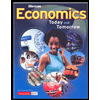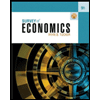
a).
To choose:An option from the given options.
a).
Answer to Problem 59P
The driver will choose the option (1) return the car with full tank.
Explanation of Solution
The driver has three options to pick given that local price is $3.5 per gallon and the car has a mileage of 25 miles per gallon and the capacity of the tank is 16 gallons and Stopping at filling station takes 20 minutes and the worth of time is $15 per hour.
The following options are as follows:
(1) return the car with full gas tank,
(2) return it without filling it and pay $5.75 per gallon or
(3) accept a fixed price of $60 for gas.
When the driver drives 150 miles.
The gas consumed and cost to filling the emptied tank is calculated as follows:
Therefore, the driver will choose to return the car with a full tank as the cost of filling the emptied tank is less than the fixed cost of $60.
b).
To choose:An option from the given options.
b).
Answer to Problem 59P
The driver will choose option (1) return car with full tank.
Explanation of Solution
The driver has three options to pick given that local price is $3.5 per gallon and the car has a mileage of 25 miles per gallon and the capacity of the tank is 16 gallons and Stopping at filling station takes 20 minutes and the worth of time is $15 per hour.
The following options are as follows:
(1) return the car with full gas tank,
(2) return it without filling it and pay $5.75 per gallon or
(3) accept a fixed price of $60 for gas.
When the driver drives 300 miles.
The gas consumed and cost to filling the emptied tank is calculated as follows:
Therefore, the driver will choose to return the car with a full tank as the cost of filling the emptied tank is less than the fixed cost of $60.
c).
To choose:An option from the given options.
c).
Answer to Problem 59P
The driver will choose option (3) accept a fixed price of $60 for gas.
Explanation of Solution
The driver has three options to pick given that local price is $3.5 per gallon and the car has a mileage of 25 miles per gallon and the capacity of the tank is 16 gallons and Stopping at filling station takes 20 minutes and the worth of time is $15 per hour.
The following options are as follows:
(1) return the car with full gas tank,
(2) return it without filling it and pay $5.75 per gallon or
(3) accept a fixed price of $60 for gas.
When the driver drives 450 miles.
The gas consumed and cost to filling the emptied tank is calculated as follows:
Therefore, the driver will choose to accept a fixed cost of $60 as this is less than the cost of filling the tank.
d).
To choose:An option from the given options.
d).
Explanation of Solution
The driver has three options to pick given that local price is $3.5 per gallon and the car has a mileage of 25 miles per gallon and the capacity of the tank is 16 gallons and Stopping at filling station takes 20 minutes and the worth of time is $15 per hour.
The following options are as follows:
(1) return the car with full gas tank,
(2) return it without filling it and pay $5.75 per gallon or
(3) accept a fixed price of $60 for gas.
When stopping at filling station takes 20 minutes and the worth of time is $15 per hour how it will affect the decision of driver.
The cost of stopping at the gas station is calculated as follows:
Part (a) When the driver drives 150 miles.
The gas consumed and cost to filling the emptied tank is calculated as follows:
Even after considering the cost of stopping at gas station driver will choose option (1) return with a full tank.
Part (b) When the driver drives 300 miles.
The gas consumed and cost to filling the emptied tank is calculated as follows:
Even after considering the cost of stopping at gas station driver will choose option (1) return with a full tank.
Part (c)When the driver drives 450 miles.
The gas consumed and cost to filling the emptied tank is calculated as follows:
Therefore, the driver will choose to accept a fixed cost of $60 as this is less than the cost of filling the tank.
Want to see more full solutions like this?
Chapter 1 Solutions
ENGINEERING ECONOMIC ENHANCED EBOOK
- Price P 1. Explain the distinction between outputs and outcomes in social service delivery 2. Discuss the Rawlsian theory of justice and briefly comment on its relevance to the political economy of South Africa. [2] [7] 3. Redistributive expenditure can take the form of direct cash transfers (grants) and/or in- kind subsidies. With references to the graphs below, discuss the merits of these two transfer types in the presence and absence of a positive externality. [6] 9 Quantity (a) P, MC, MB MSB MPB+MEB MPB P-MC MEB Quantity (6) MCarrow_forwardDon't use ai to answer I will report you answerarrow_forwardIf 17 Ps are needed and no on-hand inventory exists fot any of thr items, how many Cs will be needed?arrow_forward
- Exercise 5Consider the demand and supply functions for the notebooks market.QD=10,000−100pQS=900pa. Make a table with the corresponding supply and demand schedule.b. Draw the corresponding graph.c. Is it possible to find the price and quantity of equilibrium with the graph method? d. Find the price and quantity of equilibrium by solving the system of equations.arrow_forward1. Consider the market supply curve which passes through the intercept and from which the marketequilibrium data is known, this is, the price and quantity of equilibrium PE=50 and QE=2000.a. Considering those two points, find the equation of the supply. b. Draw a graph for this equation. 2. Considering the previous supply line, determine if the following demand function corresponds to themarket demand equilibrium stated above. QD=.3000-2p.arrow_forwardSupply and demand functions show different relationship between the price and quantities suppliedand demanded. Explain the reason for that relation and provide one reference with your answer.arrow_forward
- 13:53 APP 簸洛瞭對照 Vo 56 5G 48% 48% atheva.cc/index/index/index.html The Most Trusted, Secure, Fast, Reliable Cryptocurrency Exchange Get started with the easiest and most secure platform to buy, sell, trade, and earn Cryptocurrency Balance:0.00 Recharge Withdraw Message About us BTC/USDT ETH/USDT EOS/USDT 83241.12 1841.50 83241.12 +1.00% +0.08% +1.00% Operating norms Symbol Latest price 24hFluctuation B BTC/USDT 83241.12 +1.00% ETH/USDT 1841.50 +0.08% B BTC/USD illı 83241.12 +1.00% Home Markets Trade Record Mine О <arrow_forwardThe production function of a firm is described by the following equation Q=10,000L-3L2 where Lstands for the units of labour.a) Draw a graph for this equation. Use the quantity produced in the y-axis, and the units of labour inthe x-axis. b) What is the maximum production level? c) How many units of labour are needed at that point?arrow_forwardDon't use ai to answer I will report you answerarrow_forward
 Economics Today and Tomorrow, Student EditionEconomicsISBN:9780078747663Author:McGraw-HillPublisher:Glencoe/McGraw-Hill School Pub Co
Economics Today and Tomorrow, Student EditionEconomicsISBN:9780078747663Author:McGraw-HillPublisher:Glencoe/McGraw-Hill School Pub Co
 Survey of Economics (MindTap Course List)EconomicsISBN:9781305260948Author:Irvin B. TuckerPublisher:Cengage Learning
Survey of Economics (MindTap Course List)EconomicsISBN:9781305260948Author:Irvin B. TuckerPublisher:Cengage Learning Microeconomics: Private and Public Choice (MindTa...EconomicsISBN:9781305506893Author:James D. Gwartney, Richard L. Stroup, Russell S. Sobel, David A. MacphersonPublisher:Cengage Learning
Microeconomics: Private and Public Choice (MindTa...EconomicsISBN:9781305506893Author:James D. Gwartney, Richard L. Stroup, Russell S. Sobel, David A. MacphersonPublisher:Cengage Learning Economics: Private and Public Choice (MindTap Cou...EconomicsISBN:9781305506725Author:James D. Gwartney, Richard L. Stroup, Russell S. Sobel, David A. MacphersonPublisher:Cengage Learning
Economics: Private and Public Choice (MindTap Cou...EconomicsISBN:9781305506725Author:James D. Gwartney, Richard L. Stroup, Russell S. Sobel, David A. MacphersonPublisher:Cengage Learning





